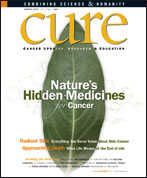Publication
Article
CURE
The Discovery of Taxol
Author(s):
A chance encounter between a botanist and a Pacific Yew tree in the 1960s yields an effective and versatile chemotherapy drug.
At an elevation of 1,500 feet, the group of modern hunter-gatherers stopped and beheld their quarry—a 25-foot specimen of Taxus brevifolia, better known as the Pacific yew tree. Why the group’s leader, 32-year-old botanist Arthur S. Barclay, PhD, had targeted this gnarled, lowly regarded conifer for his work no one knows for sure.
The important thing is, he did. Call it a hunch, luck or fate—it matters little today, four decades after Dr. Barclay stood on a hillside in the shadow of Washington’s Mount St. Helens and collected his first samples of Pacific yew needles and bark. It was all part of an improbable, government-run program aimed at finding cures for cancer in the wild.
First off, Dr. Barclay was primarily a shrub-and-seed man, with little experience in tree hunting. Dr. Barclay had spent most of two years as a field collector for both the U.S. Department of Agriculture’s New Crops Research Branch and a joint plant-screening program run by the National Cancer Institute. He’d traveled all around the Southwest, reaching into Mexico, collecting seeds and shrubs for both programs.
But by late summer 1962, Dr. Barclay found himself finishing up a West Coast plant-hunting expedition in the Gifford Pinchot National Forest flanking the old lumber town of Packwood, Washington. Very little was known about the tree he was tracking that 21st day of August, except that the Pacific yew was considered worthless as lumber material and thus shunned by loggers throughout the Northwest. Dr. Barclay and his helpers filled a sack with needles, twigs and the tree’s paper-like bark and tossed it into the back of their carry-all. It was just one of roughly 200 totally random collections he’d made in the previous four months.
Two years later, an organic chemist named Monroe Elliot Wall, PhD—working on a USDA contract at North Carolina’s new Research Triangle Park—discovered that one of Barclay’s yew tree samples—the stem bark—tested positive for cytotoxicity, meaning it was poisonous to cells. It was an encouraging sign to Dr. Wall, who had spent 20 years working as a medicinal chemist hunting for useful natural compounds in a USDA lab in Maryland. He asked the USDA to send him more yew bark.
In early September 1964, Dr. Barclay returned to the Washington hillside where he’d made his first collection two years earlier, stripped off 30 pounds of bark, dried it in the sun, and had it mailed to Dr. Wall. It would be the last time Dr. Barclay would have anything to do with the Pacific yew, returning to his plant-screening work throughout the Southwest, Mexico and down into Colombia. Dr. Barclay took early retirement for health reasons, moved to Orlando, Florida, and died in 2003.
Dr. Wall, meanwhile, teamed with a colleague, Mansukh Wani, PhD, an organic chemist he’d hired, and in 1965 the pair succeeded in extracting what turned out to be a potent cancer-killing agent in the yew bark extract. They dubbed the mystery compound K172.
In a paper the scientists submitted to the American Chemical Society in 1967, they gave K172 a nicer name: Taxol, a play on the yew’s genus, Taxus. In 1992, shortly after the compound won FDA approval for use against ovarian cancer, Bristol Myers-Squibb trademarked the name for what soon became one of the hottest cancer-fighting drugs in the world.






